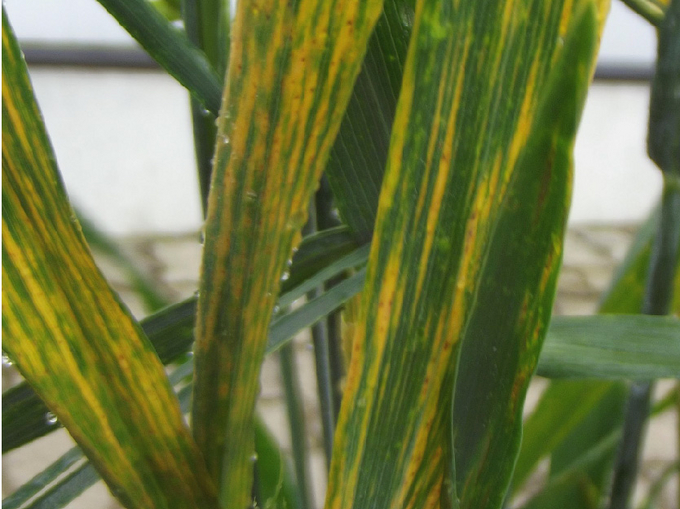Wheat streak mosaic virus
Wheat streak mosaic virus (WSMV)
Damage symptoms
Plants infected with Wheat streak mosaic virus (WSMV) remain stunted and yellow.
Leaves show irregular yellowing running parallel to the veins at the onset of the disease. Other typical symptoms include mottled leaves with green and chlorotic zones. As the disease progresses, the yellowed leaves begin to turn brown and eventually die.
The diseased plants sprout poorly and usually remain sterile. When a grain is formed, it is substantially smaller and lighter. The symptom expression and also the number of infected plants in a stand are strongly dependent on the variety, climatic conditions, as well as the basic health status of the plants (NAVIA et al, 2013).


Distribution
In Austria, the virus was detected for the first time in 2013 in a wheat plant from Lower Austria using molecular biological methods. Due to the spread of WSMV via Eastern Europe (Russia, Romania, Bulgaria, Turkey, Hungary, Slovakia, Croatia) (CAB 2005), the virus could also gain importance for Austria in the future.
Propagation and transmission
The spread and transmission of WSMV is by the gall mite Aceria tosichella. This gall mite, which is about 0.1 mm in size, belongs to the superfamily Eriophyidae (KEIFER 1969), has two pairs of legs, and can only travel short distances on leaves (RABENSTEIN et al. 2011). Because this gall mite is very light, it can be transported quickly and easily by wind.
Biology and distribution of the gall mite
The gall mite overwinters on host plants as an egg, larva, nymph, or adult. It becomes infected with WSMV while feeding on diseased plants. The gall mite subsequently transmits the viruses to additional host plants and thus acts as a vector (=transmitter) and contributes significantly to the spread of the disease. Aceria tosichella has a wide host plant range. Over 90 grass species have already been described in the literature as host plants for this gall mite. The most important host plants are the agriculturally cultivated cereal and maize varieties. Especially wheat is a preferred host plant of the gall mite (Navia et al, 2013).
Economic importance
Yield loss depends on a wide variety of factors. On the one hand, the cereal species and variety play a major role in virus multiplication and infestation intensity; on the other hand, the time of infection of a plant is of great importance. In case of an early infection (autumn), higher losses are to be expected than in case of a late infection in spring. Studies from the USA showed that losses of more than 60 % occurred with autumn infections, in contrast to a spring infection where losses of up to 15 % were recorded (HUNGER et al, 1992). Furthermore, plants stressed by more extreme climatic conditions are also more susceptible to the virus and increased yield loss must be expected.
As a result of the climatic changes predicted for the future, an increased incidence of Wheat streak mosaic virus and its vector must be expected. With a possible spread of the disease via Eastern Europe caused by the vector and by introduction via infected seeds, this disease could also gain importance in Austria.
In Austria, there is currently no information on the occurrence of the gall mite Aceria tosichella and the actual spread of the virus WSMV. Monitoring the occurrence of the disease and the gall mite in Austrian wheat fields would therefore be an important first step to assess the risk of this disease for Austrian cereal production.
Prevention and control
- The WSMV cannot be combated directly
- The spread of the viruses can only be prevented by controlling the vector.
- Germinated volunteer cereals that could act as a food source for the gall mite or reservoir for the viruses should be carefully removed (MCMULLEN & WALDSTEIN, 2010). This crop management measure reduces the food supply of the gall mite and thus curbs its reproduction.
- According to literature, direct control of gall mite is currently not an option for practice.
- An important point is the cultivation of healthy seed to prevent the primary introduction of the virus into the cereal crop.
Specialized information
Die Viruspartikel des Strichelmosaikvirus des Weizens sind leicht flexible Stäbchen mit einer Größe von 700x15 nm.
Literaturliste
Navia, D., Santos de Mendonca, R., Skoracka A., Szydlo, W., Knihinicki D., Hein, G. L., Pereira, Valle da Silva Pereira, P. R., Truol, G., Lau, D., 2013. Wheat curl mite, Aceria tosichella, and transmitted viruses: an expanding pest complex affecting cereal crops. Exp. Appl. Acarol 59, 95-143. https://doi.org/10.1007/s10493-012-9633-y
McMullen, M., Waldstein, D., 2010. Wheat streak mosaic. Plant Disease Management NDSU Extension Service. North Dakota State University.
Keifer, H. H., 1969. Eriophyid Studies C-3 (Special publication). Agricultural Research Service, United States Department of Agriculture.
Hunger R. M., Sherwood, J. L., Evans, C. K., Montana, J. R., 1992. Effects on planting date and inoculation date on severity of wheat streak mosaic in hard red winter wheat cultivars. Plant Disease 76, 1056-1060.
Rabenstein, F., Habekuss, A., Huss, H., 2011. Brome Streak Mosaic Virus (BrSMV): Ein neues Gräser- und Getreidevirus in Österreich. Der Pflanzenarzt 5.
CAB, 2005. Distribution Maps of Plant Diseases. Map No. 443 (3). CAB International in associated with EPPO.
Last updated: 12.07.2022
automatically translated